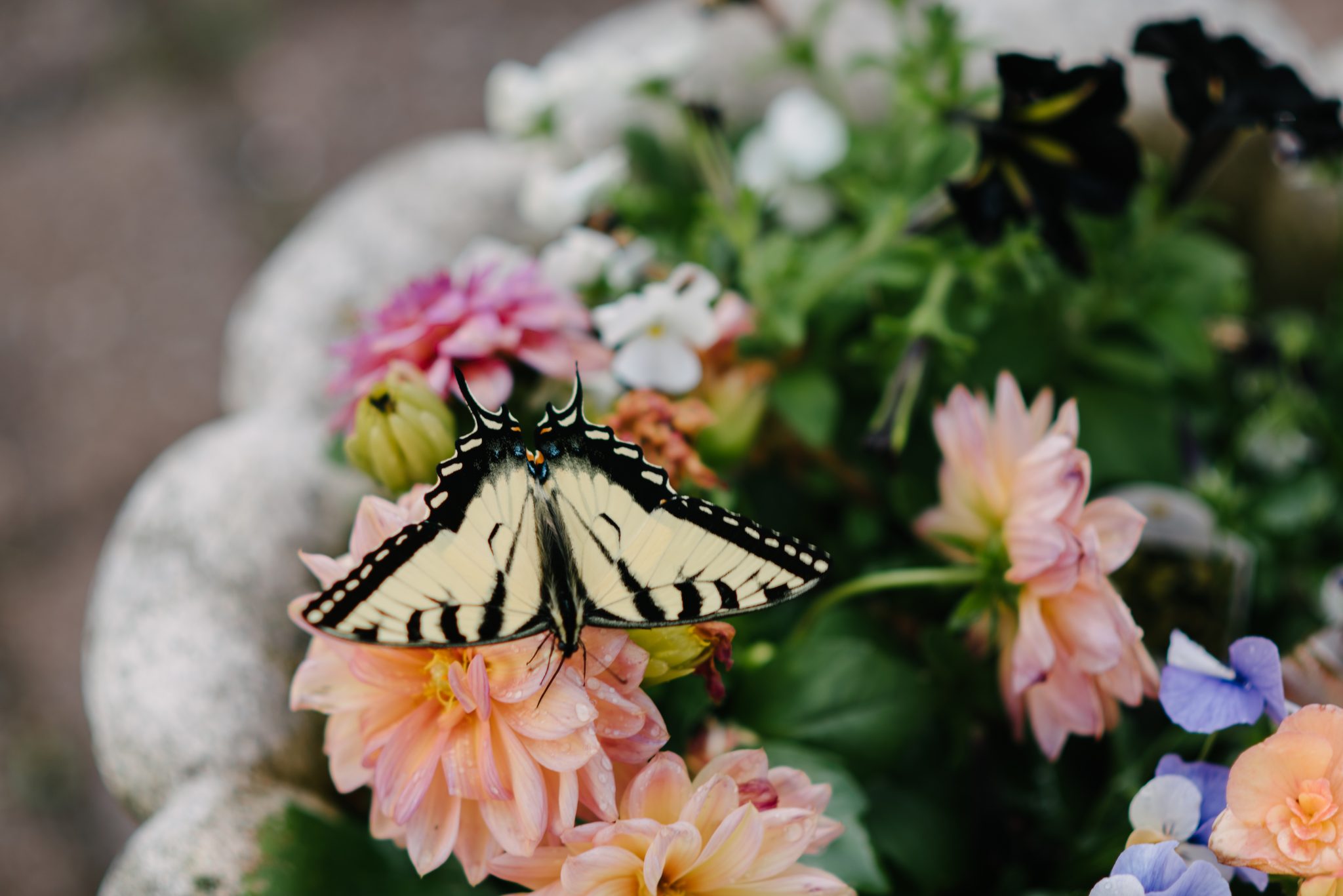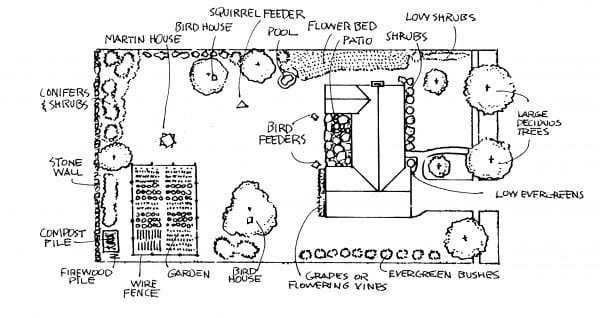Forestry & Wildlife

Your backyard can become a miniature wildlife refuge, attracting many different kinds of wild animals.
Songbirds, rabbits, frogs, bats, squirrels, and butterflies are the most common. But with careful planning and upkeep, you may find yourself watching raccoons, opossums, lizards, dragonflies, owls, and even white-tailed deer.
To be a haven for wildlife, your yard must provide the basic needs of the animals: cover, water, and food. The key to success is providing all of these elements in a suitable arrangement.
Cover means more than shelter. It is a place where an animal can escape from enemies, find refuge from the weather, and feel secure while it rests. It also means a safe place for raising young.
Different types of animals need different types of cover. The woodpecker and flying squirrel require dead trees. Rabbits make nests in tall grass and weedy areas. Deer like to spend the after noons in a secure shrubby area. You will attract more wildlife if you have a variety of cover types. A combination of trees, bushes, brushpiles, and rock piles gives the best results.
It is also very important to save some dying or dead trees (called “snags”) on your property. Many animals, including owls and squirrels, use them as nest sites.
Pick trees that are located away from buildings and utility lines to save as snags because they may fall.
A mixture of trees, of varying heights and species, attracts a variety of birds. If you do not have mature trees, nest boxes will attract some birds. Excellent plans are available for nest boxes and houses for martins, bluebirds, hawks, owls, wood ducks, flickers, and flycatchers, among others. You can build these your self or purchase them already constructed.
Bats consume great quantities of insects. For this reason, many people like to have them around their homes and gardens. Bats usually use hollow trees or attics for roosting. If these are unavailable, some types of bats will use specially designed boxes. Plans are available for building bat houses from your county office of the Alabama Cooperative Extension System.
Ask for Extension publication ANR-0622, “Bat Management in Alabama.”
Brush piles are attractive to cottontail rabbits, white- footed mice, weasels, box turtles, and white-throated sparrows. Rock piles are appealing to lizards, chipmunks, snakes, and cotton mice. Brush and rock piles are easy to build, but they must be built correctly. You can’t just throw some rocks or branches in a pile and expect results. Piles should be constructed with large rocks or branches on the bottom and the smaller materials on top. This allows fast access for wildlife near the ground as well as good over-head cover once the animal is inside the brush or rock pile.
The amount of cover you can provide will depend on the size of your yard. Even the smallest yard can hold a bird box and a few bushes that provide shelter for smaller species of wildlife.
Water
Water is critical if you want to attract wildlife to your yard. Habitat that appears good may be unused if no water is nearby. Water is necessary for drinking and is sometimes used for bathing. It is also important as a breeding site for frogs and other amphibians. Bats and birds often seek water not only for drinking but also because it attracts the insects they eat.
Water can be provided in a number of ways. A suspended birdbath will protect birds from cats and other predators. A dripping hose or shallow dish placed near bushy cover can supply water for small mammals, reptiles, and butterflies. A pool set into the ground gives the best results.
The pool can vary in size depending on your needs. It can be a small hole dug in hard clay, a bathtub sunk into the ground, a hole lined with plastic, or a concrete pool. It can be simply a hole filled with fresh water or a sophisticated pool complete with pumps and drainage controls. The level of sophistication is up to you.
The pool should be only 1 or 2 feet deep, placed in a sunny or partially shaded area, and surrounded by natural vegetation and rocks. Pools, depending on their size, can be homes for fish, amphibians, reptiles, and insects. They provide feeding sites for birds, bats, raccoons, and other animals.
It is vital that water be available year-round. In the summer, water must be replaced regularly to ensure that it is fresh. During the winter, water should be kept fresh, and ice-free, as well.
Food
Most people know that different animals eat different foods. However , many people don’t think about animals needing different foods at different times of the year. Birds that feed primarily on seeds may switch to insects while raising young in the spring. Chipmunks and bats have higher energy requirements in the spring when they wake from winter torpor (semi-hibernation) than at other times of the year. As the seasons change, so do the needs of wild animals. If you want to attract and hold animals year round, you need to provide the foods the animals need in each season.
The best way to ensure that you will meet a wide range of needs is to plant and encourage a wide variety of plant species. A flower garden will provide food for butterflies, honeybees, and hummingbirds. Humming- birds will also use special feeders filled with sugar water or commercial hummingbird nectar. Grasses that are not mowed will provide seeds for many species of small mammals and birds. Plant a combination of plants that will provide nuts, seeds, mast, fruits, berries, and flower nectar to meet the needs of a wide variety of wildlife. Plants also attract insects, worms, and spiders which, in turn, act as food for other wildlife.
Unless you already have mature bushes and trees, it will take time for you to develop a yard that produces this variety. While you are waiting for your wildlife trees and shrubs to start producing, you can get short-term food by planting annual grasses and flowers or by furnishing seeds and small grains. Seeds and grain will benefit birds and small mammals. These can be distributed in a feeder or cast out across the grass.
Planning Your Backyard Wildlife Refuge
Wildlife must have enough space to feed, breed, raise young, and take cover. When considering the essential items (cover, food, water) in your backyard wildlife refuge, you also need to think about their arrangement. Plan carefully so that you use the space you have in the most effective manner. To maximize space, intermix areas of open grass, shrubby layers, and taller trees.
While you are planning your yard, don’t forget to plan places for yourself. For instance, place the watering or feeding device within view of a window. Put a bench in a quiet, bushy section of the yard. You can even build a small observation platform in one of your trees.
Even a tiny yard is big enough to attract some animals. Although a larger area can include a greater variety of food and cover types, the smallest balcony has potential for attracting some type of wildlife. A nest box, potted plants, water dish, and bird feeder will fit in a large window box and attract birds and butterflies. No matter what kind of yard you have, you have room for wildlife.
The first step in creating your miniature wildlife refuge is to survey your yard. Find out what is out there and determine its value for wildlife. Many ornamental plants are not particularly useful. Often native vegetation is best. Draw up a plan with graph paper. Consider whether you prefer to do the work yourself or hire a landscaping firm. Decide how much money you would like to devote to your project. When you have decided these major points, you can start planting and rearranging.
Remember, the end product will take time. You can expect wildlife as soon as you have provided all the basic needs, but the amount and type will depend on the variety of food and cover you have. It will also depend on where your house is located. Homes closer to the edges of town or in the country can expect more types of wildlife than those bordered by clipped lawns and concrete. However, even in the center of a city you will get some results.
What to Plant
| Annuals | Herbaceous Plants | Low Shrubs | Tall Shrubs | Vines | Small Trees | Tall Trees |
|---|---|---|---|---|---|---|
| aster | cardinal flower | blackberry | autumn olive | Virginia creeper | dogwood | longleaf pine |
| salvia | panigrass | huckleberry | wax myrtle | Japanese honeysuckle | hawthorne | pecan |
| forget-me-not | gladiolus | dewberry | sumac | greenbriar | holly | loblolly pine |
| zinnia | lespedeza | buckeye | viburnum | yellow jessamine | southern crabapple | magnolia |
| California poppy | hollyhock | blueberry | elderberry | trumpet vine | serviceberry | ash |
| impatiens | strawberry bush | sweetleaf | poison-ivy | mimosa | hackberry | |
| marigold | larkspur | bayberry | wild grape | cherry | American beech | |
| verbena | desmodium | American beautyberry | poison-oak | sassafras | sourwood | |
| sunflower | phlox | spicebush | common persimmon | walnut | ||
| petunia | partridgeberry | mulberry | sweetgum | |||
| portulaca | sage | redcedar | oak (all species) | |||
| partridge pea | wild plum | wild cherry | ||||
| indian paintbrush | hickory | |||||
| maple | ||||||
| black gum |


